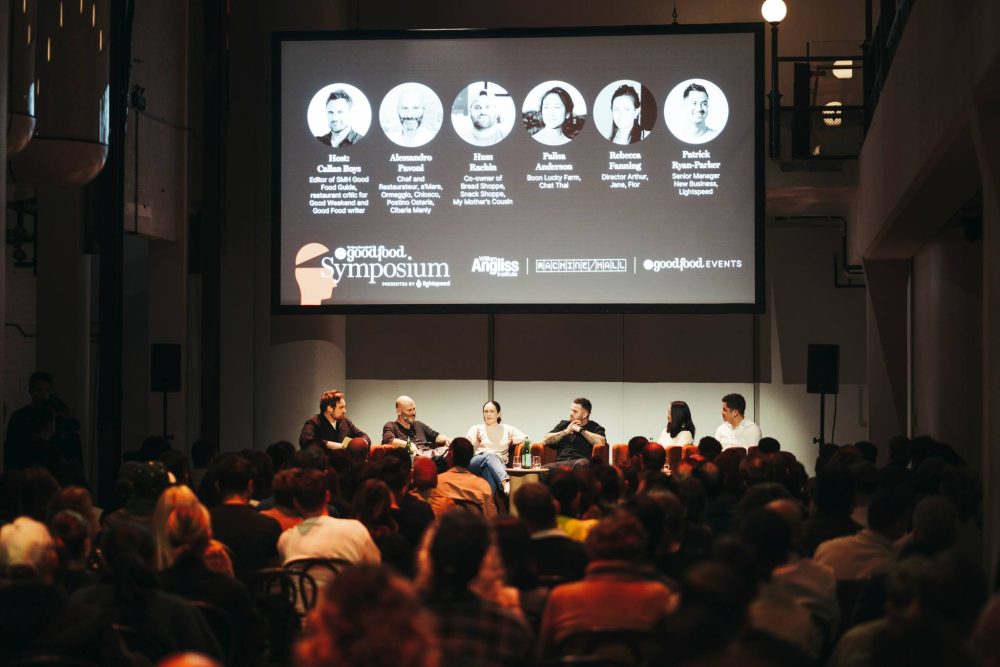
In June of this year, I was fortunate enough to partake in a first-of-its-kind hospitality event, the Good Food Symposium, in Melbourne and Sydney. The event brought together some of the industry’s most prominent figures to discuss the current challenges facing the hospitality sector, engaging an audience of several hundred restaurant owners and industry professionals.
I was joined by an incredible panel of industry leaders to tackle the most significant challenge facing hospitality businesses in 2024: the cost of living crisis.
A challenging time for hospitality
It’s no secret that the hospitality industry is facing challenging times, but we are now entering a phase of rebuilding. During the symposium, we witnessed an exchange of innovative ideas and engaging conversations about the difficulties of running a hospitality venue and how to navigate the constantly evolving customer dining experience.
Here are some of my key takeaways.
- Evolution of the dining landscape
- Changing perspectives on surcharging
- Coping with labour shortages
- Insights and technology
Evolution of the dining landscape
We kicked off the discussion by sharing perspectives on the ever-evolving dining landscape in Australia, how it’s changed over recent years and the challenges facing venues.
With a panel of diverse business owners, from fine dining to fast-casual cafes, it was insightful to hear what shifts they’d seen in the industry and the impacts on their businesses.
In an industry fraught with change, it’s clear that venues need to evolve with the times to remain relevant and appeal to as many customers as possible.
For fine dining restaurants, this means casualising your offering.
Alessandro Pavoni, owner of fine-dining restaurants Ormeggio, a’Mare, and Chiosco, made an interesting observation that since Covid, in the fine-dining world, there’s a demand for more casual dining–from the look of the venue to the style of service to the style of menu.
And this demand for casual fine dining is often driven by a desire for an elevated experience that doesn’t break the bank.
“People need to be confident they can go to a restaurant, and they don’t have to take out a mortgage to have a nice meal.” – Alessandro.
Customer expectations vs. declining margins
We couldn’t discuss the industry’s challenges without addressing the delicate balancing act of managing skyrocketing operating costs with customer expectations.
“I guess the biggest difference we’ve noticed is the profit margin. It’s getting smaller and smaller.” – Kate Reid, Founder and Co-owner of Lune Croissanterie.
While profit margins are rapidly shrinking, customer expectations are as high as ever, and diners seem to have little appreciation for the financial challenges businesses are facing.
Almay Jordaan, Owner and Executive Chef of Old Palm Liquor & Neighbourhood Wine, touched on the difficulties of meeting unrealistic customer expectations, especially in a climate of rising prices.
Customers often expect low prices and don’t want to pay for little extras. They complain about the rising price of dishes and don’t want to pay more for condiments–there’s an expectation that these should be free.
While these complaints might seem like old news and something customers have always griped about, venues can no longer afford to pander to these protests.
In the past, businesses have absorbed these costs, given out free condiments and resisted raising prices. But this just isn’t feasible anymore.
“Eventually, it does add up, and you need to start making a decision about what works… The idea is to have an open, solvent restaurant, and that’s what we were.” – Almay.

Image credit: Good Food Events
Changing perspectives on surcharging
One of the challenges I wanted to draw attention to, and feel passionately about, was the contentious issue of surcharging.
While surcharging isn’t popular amongst customers, the majority of hospitality businesses are implementing surcharges, whether for public holidays, group bookings, or the hotly contested merchant fee charge.
Data from our recent Hospitality Industry Report found that 99% of hospitality operators pass on some sort of surcharge to customers.
However, nearly 50% of customers take issue with surcharges, and 17% are so livid about being charged a surcharge that they’ll ask not to pay it or consider never returning to that venue.
There’s clearly a huge disconnect between customers and operators regarding surcharging, but venues can no longer afford to absorb these costs in pressing economic times.
And my fellow panellists agreed.
‘A 10% weekend surcharge is not enough’
This was the opinion of Alessandro Pavoni, who argued that thanks to sky-high penalty rates, many venues could not afford to open on Saturday or Sunday without charging a surcharge.
The same goes for public holidays. Many venues now opt to remain closed as they simply can’t afford to open their doors due to a 150-200% increase in staff wages.
The message was clear: if customers want to visit their favourite hospitality venues on a weekend, then they need to pay a surcharge.
This sentiment also applies to credit card surcharges, another cost operators can no longer afford to absorb. If customers want to keep enjoying their favourite hospitality venues, some leniency needs to be shown when it comes to accepting these extra costs.
Coping with labour shortages
Another key takeaway from the Symposium was the pressing issues of labour shortages and the struggle to retain quality workers.
Huss Rachid, Owner of pizzeria My Mother’s Cousin and bakery-cafes Self Raised Bread Shoppe and Self Raised Snack Shoppe, kicked off the discussion by stating that overseas workers are ‘the backbone of the industry’, yet the government isn’t doing enough to support them.
From Japanese sushi chefs to Italian pizzaiolos, foreign workers are integral to the success of the hospitality industry. However, due to increased government restrictive legislation, it’s becoming near-impossible for businesses to hire and retain foreign workers.
“It’s constantly changing the goalposts. As a collective, we need to lobby the government more: We need our voices heard.” – Huss.
The challenge of keeping staff
Aside from struggling to find staff, retaining quality staff once they’ve been hired is another hurdle for operators, and this was highlighted during the audience Q&A session.
Audience member Lis Davies, co-owner of hatted Paddington restaurant Ursula’s, questions whether staff are leaving the industry because they’ve seen how difficult owning a restaurant can be in the current climate.
And it’s an important question.
For many, hospitality is a transient industry when it comes to employment, and fewer people see hospitality as a life-long career. This mindset needs to change for the industry to survive and thrive.
Alessandro believes it’s essential to make your team feel as though “it’s not just a job, it’s a career.”
It’s crucial for owners and operators to share the vision for the future with their teams, get them involved, and help them grow with you and with the business.

Image credit: Good Food Events
Insights and technology
One of the areas I’m most passionate about is how hospitality venues can use their tech stack to make better, more informed business decisions.
When multiple platforms talk to each other, whether it’s your reservation system with your point of sale or something as simple as your EFTPOS machine with your POS, you can get more valuable information than was previously available.
Polenta chips vs chicken liver parfait
The example I always use is quantity-based reporting.
Let’s say your venue sells 500 portions of polenta chips in a week. At face value, this might appear to be your best-selling item on the menu. But when you link that with card data, you might see that when that card is used again, it never orders the polenta chips again.
I then like to compare this to something like a chicken liver parfait. Maybe you sold 12 portions that week and are inclined to take it off the menu.
However, the card data shows that the 12 people who purchased the chicken liver parfait order it every time they come back to your venue.
To add another layer, those 12 people are the ones who always order red wine that costs more than $90 per bottle. So, if we look at the bigger picture, your chicken liver parfait brings back your best, most profitable customers.
It’s all about being more targeted with the information and data that’s available to you. The more systems connected within your ecosystem, the more insights you’ll be able to leverage to help grow your business.
That’s a wrap
Joining such a talented group of professionals from Sydney and Melbourne’s hospitality community was a humbling and inspiring experience.
A heartfelt thank you to Sarah Norris and Ardyn Bernoth for launching this event and series—your vision is bringing much-needed conversations to the forefront of our industry. To Dani Valent and Callan Boys, thank you for flawlessly facilitating the panel discussion. And, to my fellow panellists, it was an honour to share the stage with you all.
Let’s continue to raise awareness about the challenges in an industry that touches all of our lives yet often remains behind the scenes and unheard.

News you care about. Tips you can use.
Everything your business needs to grow, delivered straight to your inbox.



